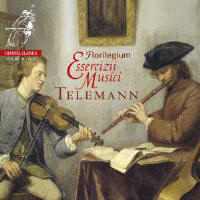Texte paru dans: / Appeared in: Channel Classics |
|
|
Reviewer: Raymond
Tuttle
Within
Telemann’s Essercizii Musici, there are 12 dozen solo sonatas (for various
instruments, plus basso continuo) and another 12 dozen trio sonatas (for two
various instruments, plus basso continuo). This double-disc set presents
seven of the latter and four of the former, with promise of more to come.
The unwary buyer could
be fooled into thinking that this collection is complete, but of course that
is not the case.
It is not certain how these
works are “exercises.” They do not seem to address any specific technical
challenge (they are not among Telemann’s most difficult works), nor are they
dedicated to anyone in particular. They are not especially emotional. We do
not know what purpose they served, when they appeared in Hamburg in 1739 or
1740. Of course none of this diminishes their value. They demonstrate
Telemann’s endless variety, skill, and imagination, and also his ability to
engage listeners intellectually, or simply to provide them with a delicious
aural treat. The solo sonatas, as presented here, highlight the flute, the
violin, the oboe, and the viola da gamba, respectively. The trio sonatas
pair those instruments with each other, or combine them with a recorder or a
harpsichord. None of these 11 works, all in four movements, are scored for
the same combination of instruments. Maybe these are exercises in the sense
that there is something for everybody; no one is allowed to sit in his or
her seat throughout the duration. That said, it also does not appear that
Telemann saw these works as part of a set, per se. It almost certainly would
have been considered weird to perform all 24, or even several of them, in
one sitting. Naturally, in this age of ready-access music, we are free to do
as we please! Channel Classics has uploaded a 71-second “teaser” for this release onto YouTube: youtube.com/watch?v=yhCGbpVOKkw. YouTube also allows you to explore alternative recordings, including the one on Deutsche Harmonia Mundi by Camerata Köln, which contains all 24 sonatas, and which made George Chien’s Want List in 1997. Camerata Köln plays the music with sobriety, which is not wrong, but it is interesting to compare, for example, the two recordings of the Flute Sonata in D, TWV D:9. Florilegium’s flutist, Ashley Solomon, plays with a brighter, more transparent tone than her counterpart in Camerata Köln, and she and her colleagues are more spontaneous. From sonata to sonata, the ensembles make different decisions about which instruments to include in the basso continuo, but none of those decisions seems mistaken to me. As for the violinist, Bojan Čičić is quite similar to his counterpart, as is oboist Alexandra Bellamy. In fact, in terms of tempo and phrasing, Florilegium and Camerata Köln are very much in the same stadium, with one group taking a slight lead here and the other group taking a slight lead there, but not so much as to create a strong preference. I recently acquired a Florilegium disc of Bach cantatas, and I loved it, so I was eager to hear this release. It did not disappoint, and I do not think that it will disappoint you. I look forward to what I presume will be the next two-CD set. | |
|
|
|
|
|
|
|
Cliquez l'un ou l'autre
bouton pour découvrir bien d'autres critiques de CD |
|




